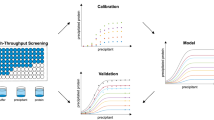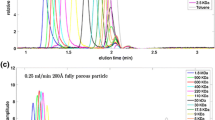Abstract
Hydrophobic interaction chromatography (HIC) is commonly used to separate protein monomer and aggregate species in the purification of protein therapeutics. Despite being used frequently, the HIC separation mechanism is quite complex and not well understood. In this paper, we examined the separation of a monomer and aggregate protein mixture using Phenyl Sepharose FF. The mechanisms of protein adsorption, desorption, and diffusion of the two species were evaluated using several experimental approaches to determine which processes controlled the separation. A chromatography model, which used homogeneous diffusion (to describe mass transfer) and a competitive Langmuir binary isotherm (to describe protein adsorption and desorption), was formulated and used to predict the separation of the monomer and aggregate species. The experimental studies showed a fraction of the aggregate species bound irreversibly to the adsorbent, which was a major factor governing the separation of the species. The model predictions showed inclusion of irreversible binding in the adsorption mechanism greatly improved the model predictions over a range of operating conditions. The model successfully predicted the separation performance of the adsorbent with the examined feed.









Similar content being viewed by others
Abbreviations
- c 1 :
-
monomer concentration in solution (mg/mL)
- c 2 :
-
aggregate concentration in solution (mg/mL)
- D a :
-
axial dispersion coefficient (cm2/s) (Eq. 22)
- D eff :
-
effective diffusivity (cm2/s) (Eq. 16)
- D f :
-
molecular diffusivity in aqueous solution
- k 1,ad :
-
monomer adsorption rate constant (ml/mg/s)
- k 2,ad :
-
aggregate adsorption rate constant (ml/mg/s)
- k −1,de :
-
monomer desorption rate constant (1/s)
- k −2,de :
-
monomer desorption rate constant (1/s)
- k 1,irr :
-
monomer unfolding rate constant (ml/mg/s)
- k 2,irr :
-
aggregate unfolding rate constant (ml/mg/s)
- k f :
-
external film mass transfer coefficient (cm/s)
- K 1 :
-
monomer binding constant (mL/mg) (Eq. 5)
- K 2 :
-
aggregate binding constant (mL/mg) (Eq. 5)
- K 3 :
-
aggregate irreversible binding constant (mL/mg) (Eq. 23)
- K 1,irr :
-
monomer irreversible binding constant (mL/mg) (Eq. 5)
- K 2,irr :
-
aggregate irreversible binding constant (mL/mg) (Eq. 5)
- L:
-
bed length (cm)
- Pe :
-
Peclet number (−)
- q 1 :
-
monomer concentration in particle (bound in native state) (mg/mL)
- q 2 :
-
aggregate concentration in particle (bound in native state) (mg/mL)
- q 1,irr :
-
monomer concentration in particle (irreversibly bound) (mg/mL)
- q 2,irr :
-
aggregate concentration in particle (irreversibly bound) (mg/mL)
- q m,irr :
-
irreversible aggregate static capacity (mg/mL) (Eq. 23)
- q m :
-
static capacity (mg/mL)
- q m1 :
-
monomer static capacity (mg/mL)
- q m2 :
-
aggregate static capacity (mg/mL)
- r :
-
radial coordinate (cm)
- R :
-
particle radius (cm)
- u :
-
interstitial velocity (cm/h)
- u s :
-
sperficial velocity (cm/h)
- z :
-
bed length coordinate (cm)
- β:
-
surface area ratio between reversible and irreversibly bound species (−) (Eqs. 1, 2)
- ε:
-
extraparticle void fraction (−)
- ρ:
-
liquid density (g/cm3)
- τ:
-
fluid residence time (min)
References
Shepard CC, Tiseliu A (1949) Discussion of the Faraday society. Hazell Watson and Winey, London, p 275
Hearn MT (2000) In: Ahuja S (ed) Handbook of bioseparation. Academic Press, New York, pp 71–235
Queiroz JA, Tomaz CT, Cabral JMS (2001) Hydrophobic interaction chromatography of proteins. J Biotechnol 87:143
Boschetti E, Jungbauer A (2000) In: Ahuja S (ed) Handbook of bioseparation. Academic Press, New York, pp 535–632
Halperin G, Breitenbach M, Tauber-Finkelstein M, Shaltiel S (1981) Hydrophobic chromatography on homologous series of alkylagaroses: A comparison of charged and electrically neutral column materials. J Chromatogr 215:211
Hjerten S, Mohammed J, Eriksson KO, Liao JL (1991) General methods to render macroporous stationary phases nonporous and deformable, exemplified with agarose and silica beads and their use in high-performance ion-exchange and hydrophobic-interaction chromatography of proteins. Chromatographia 31:85
Jennissen HP, Demiroglou A (1992) Base-atom recognition in protein adsorption to alkyl agaroses. J Chromatogr 597:93
Schwart W, Judd D, Wysocki M, Guerrier L, Birck-Wilson E, Boschetti E (2001) Comparison of hydrophobic charge induction chromatography with affinity chromatography on protein A for harvest and purification of antibodies. J Chromatogr A 908:251
Hearn MTW (2002) In: Gooding KM, Regnier FE (eds) HPLC of Biological macromolecules. Marcel Dekker, New York, p 99
Jungbauer A, Feng W (2002) In: Gooding KM, Regnier FE (eds) HPLC of biological macromolecules. Marcel Dekker, New York, pp 281–373
Pahlman S, Rosengren J, Hjerten S (1977) Hydrophobic interaction chromatography on uncharged sepharose derivatives: effects of neutral salts on the adsorption of proteins. J Chromatogr 131:99
Rosengren J, Pahlman S, Glad M, Hjerten S (1975) Hydrophobic interaction chromatography on non-charged Sepharose derivatives. Binding of a model protein, related to ionic strength, hydrophobicity of the substituent, and degree of substitution (determined by NMR). Biochem Biophys Acta 412:51
Melander WR, Horvát C (1977) Salt effects on hydrophobic interactions in precipitation and chromatography of proteins: an interpretation of the lyotropic series. Arch Biochem Biophys 183:200
Melander WR, Horvát C (1984) Salt-mediated retention of proteins in hydrophobic-interaction chromatography: application of solvophobic theory. J Chromatogr 317:67
Wu SL, Figueroa A, Karger BL (1986) Protein conformational effect in hydrophobic interaction chromatography: retention characterization and the role of mobile phase additives and stationary phase hydrophobicity. J Chromatogr 371:3
Roettger BF, Myers JA, Ladisch MR, Regnier FE (1989) Adsorption phenomena in hydrophobic interaction chromatography. Biotechnol Prog 5:79
Perkins TW, Mak DS, Root TW, Lightfoot EN (1997) Protein retention in hydrophobic interaction chromatography: modeling variation with buffer ionic strength and column hydrophobicity. J Chromatogr A 766:1
Xia F, Nagrath D, Cramer SM (2003) Modeling of adsorption in hydrophobic interaction chromatography systems using a preferential interaction quadratic isotherm. J Chromatogr A 989:47
Janson J, Rydén L (eds) (1998) Protein purification, 2nd edn. Wiley-VCH Inc., New York, pp 283–296
Saito Y, Wada A (1983) Comparative study of GuHCl denaturation of globular proteins. I. Spectroscopic and chromatographic analysis of the denaturation curves of ribonuclease A, cytochrome c, and pepsinogen. Biopolym Pept Sci Sect 22:2105
Goheen SC, Engelhorn SC (1984) Hydrophobic interaction high-performance liquid chromatography of proteins. J Chromatogr 317:55
Benedek K, Dong S, Karger BL (1984) Kinetics of unfolding of proteins on hydrophobic surfaces in reversed-phase liquid chromatography. J Chromatogr 317:227
Wu S-L, Benedek K, Karger BL (1986) Thermal behavior of proteins in high-performance hydrophobic-interaction chromatography On-line spectroscopic and chromatographic characterization. J Chromatogr 359:3
Oroszlan P, Blanco R, Lu X-M, Yarmush D, Karger BL (1990) Intrinsic fluorescence studies of the kinetic mechanism of unfolding of α-lactalbumin on weakly hydrophobic chromatographic surfaces. J Chromatogr 500:481
Lu XM, Benedek K, Karger BL (1986) Conformational effects in the high-performance liquid chromatography of proteins Further studies of the reversed-phase chromatographic behavior of ribonuclease A. J Chromatogr A 359:19
Fausnaugh JL, Kennedy LA, Regnier FE (1997) Comparison of hydrophobic-interaction and reversed-phase chromatography of proteins. J Chromatogr 317:141
De Frutos M, Cifuentes A, D’ıez-Masa JC (1997) Multiple peaks in high-performance liquid chromatography of proteins ß-lactoglobulins eluted in a hydrophobic interaction chromatography system. J Chromatogr A 778:43
Goheen SC, Gibbins BM (2000) Protein losses in ion-exchange and hydrophobic interaction high-performance liquid chromatography. J Chromatogr A 890:73
Karger BL, Blanco R (1989) The effect of on-column structural changes of proteins on their HPLC behavior. Talanta 36:243
Goheen SC, Gibbins BM, Hilsenbeck JL, Edwards JV (2001) ACS Symp Ser 792:20
McNay JL, Fernandez EJ (1999) How does a protein unfold on a reversed-phase liquid chromatography surface? J Chromatogr A 849:135
Buijs J, Costa Vera C, Ayala E, Steensma E, Hakansson P, Oscarsson S (1999) Conformational stability of adsorbed insulin studied with mass spectrometry and hydrogen exchange. Anal Chem 71:3219
Tibbs Jones T, Fernandez EJ (2003) Alpha-lactalbumin tertiary structure changes on hydrophobic interaction chromatography surfaces. J Colloid Interface Sci 259:27
Jones TT, Fernandez EJ (2004) Hydrophobic interaction chromatography selectivity changes among three stable proteins: conformation does not play a major role. Biotechnol Bioeng 87:388
Lundstrom I (1985) Models of protein adsorption on solid surfaces. Prog Colloid Polym Sci 70:76
Jungbauer A, Machold C, Hahn R (2005) Hydrophobic interaction chromatography of proteins: III. Unfolding of proteins upon adsorption. J Chromatogr A 1079:221
Haimer E, Tscheliessnig A, Hahn R, Jungbauer A (2007) Hydrophobic interaction chromatography of proteins IV: kinetics of protein spreading. J Chromatogr A 1139:84
Yang H, Etzel MR (2003) Evaluation of three kinetic equations in models of protein purification using ion-exchange membranes. Ind Eng Chem 42:890
Langmuir I (1918) The adsorption of gases on plain surfaces of glass, mica, and platinum. J Am Chem Soc 40:1361
Bellot JC, Condoret JS (1993) Modelling of liquid chromatography equilibria. Process Biochem 28:365
Ruthven DM (ed) (1984) Principles of adsorption and adsorption processes. Wiley Interscience, New York
McKay G, Duri BA (1989) Prediction of multicomponent adsorption equilibrium data using empirical correlations. Chem Eng J 41:9
Katti AM, Guiochon G (1988) Prediction of band profiles in displacement chromatography by numerical integration of a semi-ideal model. J Chrom 449:25
Katti AM, Guiochon G (1990) Quantitative comparison between the experimental band profiles of binary mixtures in overloaded elution chromatography and their profiles predicted by the semi-ideal model. J Chrom 499:21
Phillips MW, Subramanium G, Cramer SM (1988) Theoretical optimization of operating parameters in non-ideal displacement chromatography. J Chrom 454:1
Quiñones-Garcia I, Rayner I, Levison PR, Dickson N, Purdom G (2001) Performance Comparison of suspended bed and batch contactor chromatography. J Chromatogr A 908:69
McCue JT, Kemp G, Low D, Quiñones-Garcia I (2003) Evaluation of protein-A chromatography media. J Chromatogr A 989:139
Weaver LE, Carta G (1996) Protein adsorption on cation exchangers: comparison of macroporous and gel-composite media. Biotechnol Prog 12:342
Foo SC, Rice RG (1975) On the prediction of ultimate separation in parametric pumps. AIChEJ 21:1149
Deuflhard P (1974) A modified Newton method for the solution of ill-conditioned systems of nonlinear equations with application to multiple shooting. Numer Math 22:289
Schenk O, Gärtner K (2002) Two-level scheduling in PARDISO: improved scalability on shared memory multiprocessing systems. Parallel Comput 28:187
Schenk O, Gärtner K (2004) Solving unsymmetric sparse systems of linear equations with PARDISO. J Future Generation Comput Syst 20:475
Gärtner K, Schenk O, Fichtner W (1999) Parallel multigrid methods for the continuity equations in semiconductor device simulation. Speedup J 12:67
COMSOL Multiphysics Command Reference (2006) Version 3.3, p 193
Tyn MT, Gusek TW (1990) Prediction of diffusion coefficients of proteins. Biotechnol Bioeng 35:327
Acknowledgments
The authors would like to thank Joshua Walker and Phil Vilmorin (Biogen Idec Corporation) for preparation of the feed solution. The authors would also like to thank Doug Cecchini (Biogen Idec Corporation) and Mina Sierou (Comsol, Inc.) for useful technical discussions.
Author information
Authors and Affiliations
Corresponding author
Rights and permissions
About this article
Cite this article
McCue, J.T., Engel, P., Ng, A. et al. Modeling of protein monomer/aggregate purification and separation using hydrophobic interaction chromatography. Bioprocess Biosyst Eng 31, 261–275 (2008). https://doi.org/10.1007/s00449-008-0200-1
Received:
Accepted:
Published:
Issue Date:
DOI: https://doi.org/10.1007/s00449-008-0200-1




